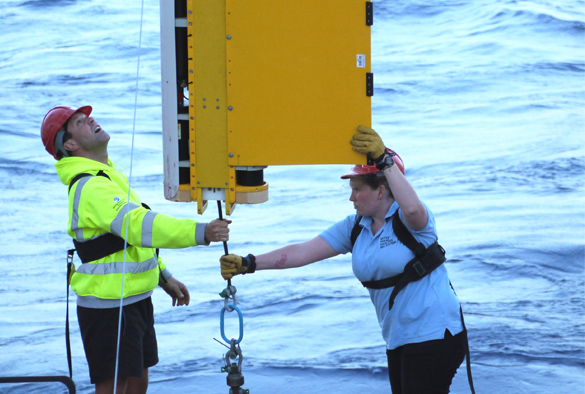CarTRidge: Enhanced carbon export driven by internal tides over the mid-Atlantic ridge

Oceanographers from the University of Liverpool’s School of Environmental Sciences will be leading a research expedition to the mid-Atlantic ridge to investigate how turbulence generated over the ridge leads to increased export of carbon from the sea surface to the ocean depths.
Most plankton growth in the ocean occurs in the warm surface waters, where there is plenty of sunlight. This warm layer is separated from deeper, colder, nutrient-rich waters by the thermocline. In an earlier project the research team found that underwater waves travelling along the thermocline, which were caused by tides flowing over the ridge, led to increased mixing of deep ocean nutrients up towards the sea surface, and also increased light at the thermocline as the thermocline was pushed closer to the sea surface by the waves. These increased supplies of nutrients and light to the plankton at the sea surface are expected to have a profound effect on the role of the ocean’s biology in Earth’s carbon cycle and climate. Plankton affect Earth’s climate by absorbing carbon in the upper ocean, which causes the sea to absorb carbon from the atmosphere. Dead plankton then sink to great depths, ultimately removing the carbon from the atmosphere and burying it in the deep ocean.
Larger plankton are better at removing carbon to the ocean depths, because they contain more carbon and they sink more quickly. Increased nutrients and light are expected to shift the ridge plankton community towards having these larger plankton species. Thus, the ocean over the mid-Atlantic ridge should be better at exporting carbon to depth compared to waters away from the ridge that are not influenced by the thermocline waves.
The Liverpool scientists are leading a team of researchers, with colleagues from Herriot Watt University, the University of Southampton and the National Oceanography Centre. They will spend about 5 weeks on a research ship in the South Atlantic, linking the physics of thermocline waves, through the supplies of nutrients and light to the plankton, to the changes in the plankton community and the subsequent sinking particles and carbon export. Lead scientist Professor Jonathan Sharples from the University of Liverpool says “This is a really exciting, multi-disciplinary project that we think is going to fill a massive gap in our understanding of how the ocean affects Earth’s climate. Ocean biology is critical, but how it works is determined by the physics of the deep ocean; we need to make the right measurements to link the physics and biology in a challenging open ocean environment.”
The project is funded through the Natural Environment Research Council’s “Pushing the Frontiers” scheme, which aims to support ambitious, high-risk, high-reward environmental science.